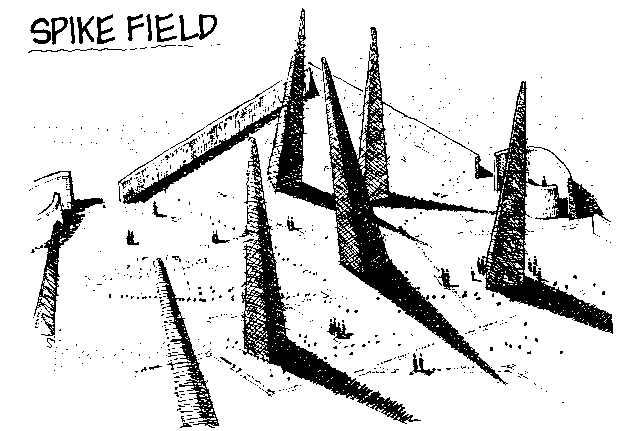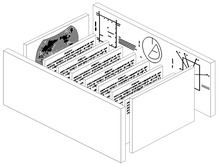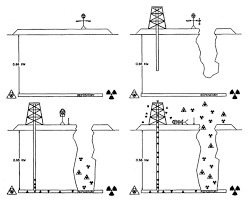A Blog to write articles and compile facts about Nuclear Power. A main goal is to end the stigma around Nuclear Power, along with educating about the realities of nuclear weapons and war. Run by one woman from the comfort of her home.
Last active 3 hours ago
Don't wanna be here? Send us removal request.
Text










Proposed concepts for long-time nuclear waste warning messages for the Waste Isolation Pilot Plant in New Mexico, designed to universally warn far-future Human descendants of buried atomic waste
31K notes
·
View notes
Text
I rarely post to this blog, and I'm very sorry. Been busy
I'm in a bio program at school and I go to a very "Green" college. That's really neat and all but they are the opposite of green and it's frustrating. They are the hippie "woke" kind of green that is more words than actual substance, all the while shutting down the local small farmer who is just trying to make ends meet.
Anyways, i recently got into a small debate with a classmate during class about Nuclear Energy. I pointed out to my professor that Nuclear energy needs to looked at as a good alternative, as I'm sure most of my followers agree with. This guy started shouting off every anti nuclear talking point there is. He tone was very "gotcha" and he got more and more sour as I respectively countered every argument. I sent him a canvas mail, going in depth. He says I didn't talk about Three Mile Island enough.
To that I was like

Three Mile Island happened in 1979 and was the critical point for nuclear regulations in the United States. Nuclear had been used for around almost two decades before then. I was very explicit about Chernobyl and Fukishima, but apparently stating that Three Mile Island was a "Best Case Scenario" for a melt down scenario didn't sit well with him.
Given that the corium remained IN the reactor core and didn't leak out (As opposed to Chernobyl, which melted out of a badly designed reactor.) this IS the best case scenario for a scenario that is already very unlikely.
People like this frustrate me. They already made up their mind about something, and when given factual counter arguments, they refuse to hear it.
I explained that Nuclear Energy has been used on a civiliean scale since the 1950s, and that theres only been three major accidents. Coal, Oil, Natural Gas Accidents: Oil Spills : Linking this because its A LOT.
Mining Accidents: (Note this includes non-coal related accidents, which may include Uranium. You can choose to list this with Nuclear or not.)
"Between 1980 and 2005, coal-fired power plants saw an average of 11 fires/explosions, 29 injuries, and 5 deaths each year." -FE Moran
Oil Rig Accidents: Oil Rigs are an extremely dangerous place to work. The list goes on and on and on. Greener Energy, such as wind and solar, is not without issues. I suppose I need to preface that while I'm anti fossil fuel, I don't believe in simply cutting it off and that we need to slowly wean our dependency from it. I'm not anti-green energy, either. Nuclear doesn't work everywhere. There is no "One size fits all" power source for the entire planet.
My goal with this hobby and interest is to teach people that nuclear is not to be feared and demystify it.
12 notes
·
View notes
Text
Eric Schlosser wrote a book about nuclear weapons and safety called Command and Control. Its a fascinating read. I recommend it.
Worth noting that the picture above is from the Castle Bravo detonation, which was 15 MT. Far larger than they expected.



The 1961 Goldsboro Nuclear B-52 Crash
On the midnight of January 23-24, 1961 a B-52 Stratofortress took off from Seymour Johnson Air Force Base in Goldsboro, North Carolina. The bomber's mission was to conduct a regular air patrol over Arctic airspace just in case the Cold War should suddenly become very hot. Shortly after takeoff, the bomber's pilot, Major Walter Scott Tulloch, noticed a fuel leak coming from the right wing. Suddenly, the plane lost 37,000 pounds of fuel as the leak worsened. Major Tulloch decided to cancel the mission and return to base, but suddenly the right began to rapidly disintegrate. Before the B-52 could land safely, the crew lost control of the plane, and the B-52 began to spiral to the Earth at 9,000 feet.
The crew abandoned the plane, with five bailing out or ejecting, one being killed after bailing out, and two dying in the subsequent crash. While the loss of life is certainly a tragedy, what makes the 1961 Goldsboro crash an especially noteworthy incident was the payload that the B-52 was carrying at the time; two Mark 39 nuclear bombs. The Mark 39 was a nuclear fusion hydrogen bomb with a yield of 3.8 megatons, roughly 200 - 300 times the power of the bombs dropped on Hiroshima and Nagasaki.
The two bombs were accidentally jettisoned before the crash, resulting in one plummeting to the ground and embedding itself deep within the muck of a muddy North Carolina field. The second's parachute deployed, resulting in a somewhat gentle return to earth. Both bombs were recovered safely. However, analysis of the bombs determined that before being ejected from plane, the bomb whose parachute had activated had actually completed it's arming sequence. It's theorized that the centrifugal forces of the spiraling plane had pulled a lanyard in the cockpit which was used to arm the bomb. The only reason the bomb did not detonate was due to a single safety switch not being activated, which would have armed the conventional explosives on the bomb. So in other words, the nuclear components of the bomb were activated, had the conventional explosives detonated, well... then ... this would have happened ...

Fortunately for the good people of Goldsboro, North Carolina, that did not happen. The US Government and Air Force downplayed the incident, claiming that there was absolutely no chance of an accidental detonation occurring. It wasn't until 2013 that the true extent of the accident was revealed after an investigative journalist named Eric Schlosser was able to obtain declassified documents through the Freedom of Information Act.

704 notes
·
View notes
Photo
Little squares are where the control rods are are, I believe. Shows how big these things are.

Крышка атомного реактора РБМК 1-го энергоблока ЧАЭС.
Cover of the RBMK nuclear reactor No. 1 of the Chernobyl Nuclear Power Plant.
2K notes
·
View notes
Text
Monticello Power Plant: The Oddball

Monticello Nuclear Generating Station is uh, strange. Always been weird to me. The reactor vessel isn’t incased in a dome like most others, and it lacks cooling towers. It also has this odd tower that almost looks like a smoke stack, but it’s...not.

Seriously, what is that?
8 notes
·
View notes
Text
You can find where they keep the casks on Google Maps!
A little fun thing I like to do on google maps is find Nuclear Plants and pick out all the parts.
In this example, we’re going to be using Plant Farley, in Dothan Alabama.


Not all plants have these. The white “Bunker” is actually a storage shed for emergency supplies. Bulldozers, vests, geiger counters. Anything they could need for any possible emergency, including flooding, earthquake, etc.

Not really good at electrical things, but this is where they (Quite obviously) send out the electricity to the grid. I imagine it’s switched and changed to fit different voltage and what not. There are others who follow me that understand electricity more than I.

Admin building. Every plant has one of these. This is the business side of things.

Dry Storage! 50 Casks here!

Turbine building on the left, reactors on the right. All reactors are (with some exceptions.) generally in domed buildings made of reinforced concrete with rebar thicker than your thigh.

Some plants differ when it comes to cooling. Some have towers, which you are familiar with. Some have vents, like shown above, and others vent their heat directly into the river. (Waste heat and thermal pollution is detrimental to local wildlife, so I’m not a fan of this approach.) Each reactor gets its own tower or set of vents. When I drove around these, it was a permanent shower of warm, clean water. Pretty amazing!

In take. Every plant needs a place where they take in water for their cycle. This includes non-nuclear plants too. Usually the intake is close to the reactor vessel, but in this case, its several thousand feed away. Plant Farley is a wildlife preserve, with tons of Alabama native wildlife living on site.
14 notes
·
View notes
Text
The Three Levels of Radioactive Waste
fue

(Image Transcription: Barrels of Low-Level Radioactive Waste in a storage facility in Thailand.)
I made a post recently about what nuclear waste is, and I made a small error in saying that nuclear waste is always a solid. I was talking about the high level waste. Some nuclear waste is a liquid, but its generally always low-mid level waste. So what does this mean?
Low Level Radioactive Waste: LL (Low Level) waste is defined as anything that has come in contact with radiation, through at a power plant or medical device. This includes clothing, needles, storage devices, and liquids. It also includes any element with less then a 5 year half-life. Mid-Level Radioactive Waste:
ML waste (Or Intermediate) is any waste that requires shielding, but not cooling. Resins, sludge, and fuel cladding fit into this category.
High-Level Radioactive Waste (HL) HL waste is the end of the fuel cycle, and requires cooling before it can be put into a cask and stored.

It’s all stored in pools for about 20 years before it’s cool enough to transfer to massive concrete casks. These are all stored on site! Any news you’ve heard about Yucca Mountain isn’t true, because the NRC hasn’t given the go ahead to use it as a repository. Nuclear Reprocessing is rare these days, and isn’t public information. While I seriously doubt it doesn’t happen, the Nuclear Plant I went too had the exact amount of casks they should have. (Been open since 1970, with a refueling cycle of about every 4 years.)
20 notes
·
View notes
Text
I’m currently attending UMN Morris.
It’s been interesting because I really don’t belong to either party. I am the definition of centrist, and I take ideals from both parties. Because of that, liberals hate me, and so do conservatives.
My pushing for Nuclear Power, especially modern designs, has received a lot of push back in my class. I’m taking an environmental studies class, that talks about waste, the realities of recycling, major environmental issues such as mining. It’s a good class!
Of course, my classmates are rather ignorant about Nuclear Power and I am constantly asked this question. “WhAt AbOuT tHe WaSte?!
What about it?

Need I remind everyone in the hall that Nuclear Waste is a solid, not a liquid. It’s stored in massive concrete canisters filled with argon and sealed. These guys will sit here forever. Not the best solution, but it’s hardly a problem. It’s kind of like the landfill issue: We WILL run out of space.
Which is why I push for modern designs. We don’t have any commercial fast reactors.
“Fast reactors are capable of destroying the longest-lived nuclear waste, transforming it to waste that decays to harmlessness in centuries rather than hundreds of millennia.“ -https://whatisnuclear.com/
Gobbling up already used fuel seems a good way to cut down on waste, no?
Then there's the Thorium fuel cycle. It produces waste, yes, but its dangerous for a much, MUCH shorter time frame.
So until we can get these modern reactors online, I think our current arrangement is good. Not the best, but hey: Neither are landfills. But they work just fine for now.
15 notes
·
View notes
Note
Hello, I'm currently in the International Baccalaureate progam and I'm writing my main essay on the effects that cold war politics had on the development of nuclear power. I was wondering if you would be able to suggest any sources on the subjects.
Command and Conquer is an excellent book on the Cold War and nuclear weapons. In general Nuclear Power was very popular during the Cold War because it was a great way to make plutonium for nuclear weapons.
3 notes
·
View notes
Photo


By the bomb’s early light: American thought and culture at the dawn of the atomic age, 1946
387 notes
·
View notes
Photo

Queen crowned at the Miss Atomic Bomb Pageant, 1950.
335 notes
·
View notes
Text
Call out post =\
seduces you by reciting different models of nuclear bomb and their effective blast radius
33 notes
·
View notes



